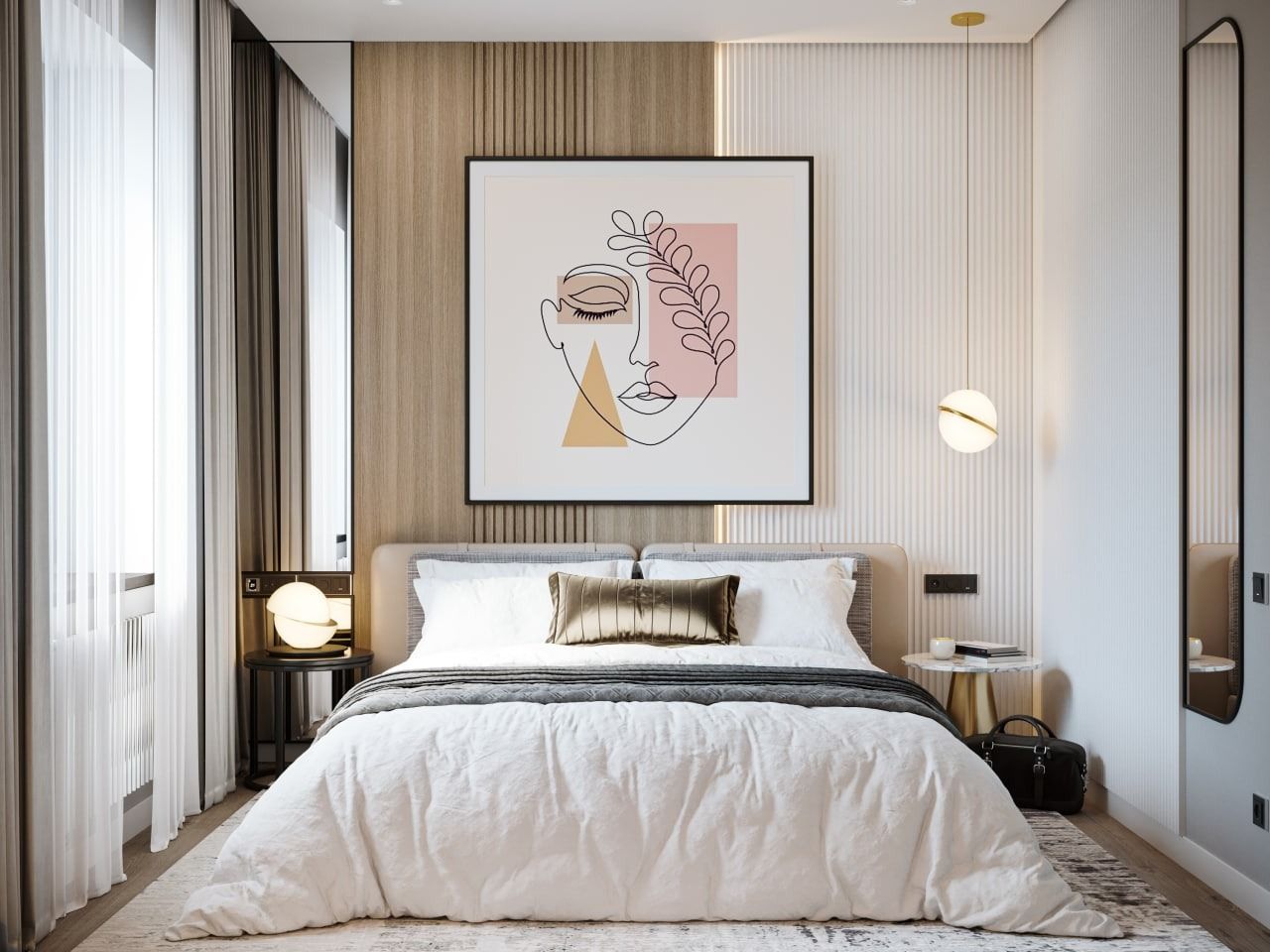Hotel Design: 6 Points to Make Your Hotel Room Maximum Comfortable
Hotel Design: How to Make a Hotel Room Maximally Comfortable?
A hotel room is where guests spend a significant portion of their time during travel or business trips. Hence, it is crucial for the room to be not only clean and convenient but also to create a pleasant atmosphere that promotes relaxation and rest. The design of the hotel room is a key factor influencing guest satisfaction and can impact their choice of a hotel in the future.
In this article, we will explore the essential criteria for comfort in a hotel room and provide detailed insights on how to correctly select furniture, lighting, color schemes, and other design elements to create the ideal space for relaxation and work.

1. The primary comfort criterion in a hotel room is a comfortable bed and quality bedding.
When we travel, one of the most critical considerations is choosing the right hotel room. Undoubtedly, one of the key factors influencing the convenience and comfort of a stay is the bed and bedding in the room. Guests spend a significant part of their time resting and recharging on the bed. Therefore, the quality and cleanliness of the bedding and towels must be impeccable. An excellent mattress topper should not be overlooked.
2. To achieve maximum comfort, it is essential to consider guests' individual needs and provide various options for pillows, blankets, and mattresses.
One crucial aspect of creating a comfortable atmosphere in hotel rooms is considering the individual needs of each guest. People have different preferences regarding mattress firmness, pillow size, and blanket thickness. To ensure maximum comfort for all guests, offering various options for these elements is essential.
Additionally, providing a choice of bedding can further enhance the room's comfort level. Guests often appreciate having options, so if a hotel offers multiple mattress, pillow, and blanket choices, it can significantly elevate the comfort of their stay. Therefore, hotels aiming to provide utmost comfort for their guests should consider individual needs and offer a selection of bedding.
The selection process for these elements can be carried out remotely during the reservation process or in-person upon arrival, presenting guests with a box illustrating the materials and characteristics of pillows and blankets.

3. A well-thought-out lighting system in the room allows for creating the desired atmosphere and accentuating design choices.
An effective lighting system enables the creation of the desired ambiance in the room and emphasizes design features. For instance, using various light sources like table lamps and accent lighting allows guests to create different zones in the room for work, reading, or relaxation. This can be particularly important for business travelers who may need to work in the room during the day.
Moreover, a well-planned lighting system can enhance the room's aesthetic appeal. Lighting, for instance, can highlight interior decorative elements such as paintings, sculptures, etc., creating a cozy and stylish ambiance. This can be particularly crucial for hotels aiming to attract clients with their unique design and style.
Hotel Design: Maximizing Guest Comfort through Thoughtful Details
When it comes to hotel room design, aesthetics should be complemented by functionality and user-friendliness. To ensure guests' utmost comfort, lighting plays a crucial role. Avoiding direct, bright lighting near the bed promotes better sleep quality as bright lights can hinder falling asleep quickly. Instead, opting for fixtures with lampshades or light diffusers, such as sconces, table lamps, pendants, or chandeliers, helps create a relaxing ambiance and aids in a peaceful slumber.
During the design phase, consider how guests will control the lighting system. Easily accessible switches, preferably within reach from the bed, enable guests to turn off forgotten lights without getting up.
4. Guest Convenience in the Room: Spatial Planning, Comfortable Furniture, and Essential Amenities
To ensure guests' ultimate comfort, hotels should focus on well-thought-out spatial arrangements, comfortable furniture, and the provision of necessary amenities. Adequate storage space and room to move around should be offered. Functional and comfortable furniture, such as a cozy chair or sofa for relaxation and a well-equipped workspace with electrical outlets for business travelers, are essential. The presence of luggage racks or designated space for luggage storage in the room enhances the traveler's positive experience.
Furthermore, providing guests with necessary appliances and devices like a TV, refrigerator, electric kettle, coffee maker, hairdryer, iron, etc., ensures their stay is convenient. All appliances should be functional, well-maintained, and intuitive to use. Guests should feel at home, enjoying all essential amenities and services. As an unusual offering, consider safes with built-in internal power sockets. This allows guests to securely lock and charge their valuable gadgets simultaneously.
Hotel classification is based on various criteria, including in-room amenities. The more amenities provided, the higher the hotel's class. Key amenities impacting hotel classification include bed quality and size, air conditioning and heating availability, the presence of a mini-bar, kettle, hairdryer, safe, and wireless internet access. A clean, well-maintained room equipped with all essential conveniences contributes to a comfortable stay. Additional amenities like a swimming pool, spa center, restaurant, bar, etc., can further elevate a hotel's class and attract more guests.
Overall, hotels should strive to create a welcoming environment in their rooms, taking into account the individual needs and preferences of each guest. Well-planned spatial arrangements, comfortable furniture, and essential amenities can maximize a room's comfort and convenience for guests.
5. Creating a Cozy Atmosphere in Hotel Rooms through Effective Use of Color, Texture, and Materials
Besides aesthetics, the effective use of color, texture, and materials helps establish a cozy atmosphere in hotel rooms. Color schemes can influence guests' moods and psychological state. Some hotels opt for neutral tones like white, beige, or gray to create a clean, uncluttered appearance. Others choose more vibrant colors to achieve a distinctive interior. The designer's touch is evident in the combinations of rich hues and color blending to align with the hotel's vision. The optimal wall color in a hotel room depends on the overall concept and design and the desired atmosphere. Thematic rooms may represent elements like Russian fairytales, global folklore, seasons, or famous personalities, providing a captivating and memorable experience. However, these themes may not suit all target audiences.
Moreover, understanding the psychology of color helps designers create quality interiors. Cool colors like blue, green, and purple can establish a tranquil and soothing atmosphere, while warm colors like red, orange, and yellow create a more vibrant and dynamic ambiance.
Considering the room's orientation to natural light can also influence color choices. South-facing rooms usually receive more sunlight and warmth, allowing for cooler color options to balance the atmosphere. North-facing rooms might benefit from warmer colors to create a cozier, more comfortable ambiance. Considering these factors when selecting a color palette for hotel rooms ensures an ideal blend of comfort and coziness for guests.
Hotel Design: Elevating Guest Comfort with Thoughtful Elements
In addition to aesthetics, the proper use of colors, textures, and materials can accentuate the room's design and create a cohesive interior. For instance, if the room follows a modern style, incorporating vibrant accent colors and contemporary materials can amplify its effect. Conversely, for a classic style, neutral colors and traditional materials are more fitting. Mixing different textures while keeping a consistent color palette or using various colors in the furniture upholstery with one type of fabric can add interest to the interior.
By combining different materials and textures, hotel rooms can achieve a well-crafted, deep design. Soft carpets, cozy bed throws, and plush decorative pillows contribute to a feeling of comfort and coziness. Employing contrasting and unexpected combinations of rough and soft elements, natural materials with metal, textiles with natural stone, allows the interior to be memorable. On a subconscious level, guests are drawn to return where they felt good. Employing different textures plays with the user's sensations, making their experience unforgettable.

Safety regulations also play a crucial role in material selection for hotel interiors. The requirements for fire safety are specified in the Federal Law No. 123-FZ Technical Regulations on Fire Safety (as of April 30, 2021).
Wall, floor, and ceiling coverings should be fire-resistant and non-combustible, using special fireproof wallpapers, tiles, or paints. Furniture and textiles must also be made of fire-resistant materials. Additionally, smoke detectors and fire extinguishers should be installed in rooms, and evacuation routes must be clearly marked and free of obstacles. All these measures help ensure guest safety in case of a fire.
6. A Functional Bathroom with Modern Plumbing and Quality Toiletries is Crucial for Guest Comfort.
Bathroom amenities significantly influence hotel classification. Modern plumbing fixtures like showers, bathtubs, and washbasins with mixers, as well as high-quality toiletries such as shampoos, shower gels, and toilet paper, are a must for any hotel striving for a high-class rating. Additionally, providing extra conveniences like hairdryers, makeup mirrors, weighing scales, and bathrobes with slippers can further enhance the hotel's rating.
Modern plumbing and branded toiletries are expected in hotel bathrooms, just as a shower with good water pressure and clean towels. These details in room design create pleasant impressions and leave a positive impact on visitors' perception of the hotel.
Creating a comfortable and cozy hotel room is a crucial task for any establishment. To achieve this, it is essential to consider guests' needs and provide a wide range of amenities, from comfortable beds to modern technology and cosmetic products. Additionally, the functionality and quality of the bathroom are among the most critical comfort criteria that can influence a hotel's star rating. Understanding that room design details play a vital role in creating a pleasant atmosphere and leaving a positive impression on visitors, they deserve ample attention and consideration.
Explore 8 HOTEL PRACTICES WORTH USING AT HOME HERE.
Request a consultation with interior designers for hotel room design by filling out this FEEDBACK FORM.


